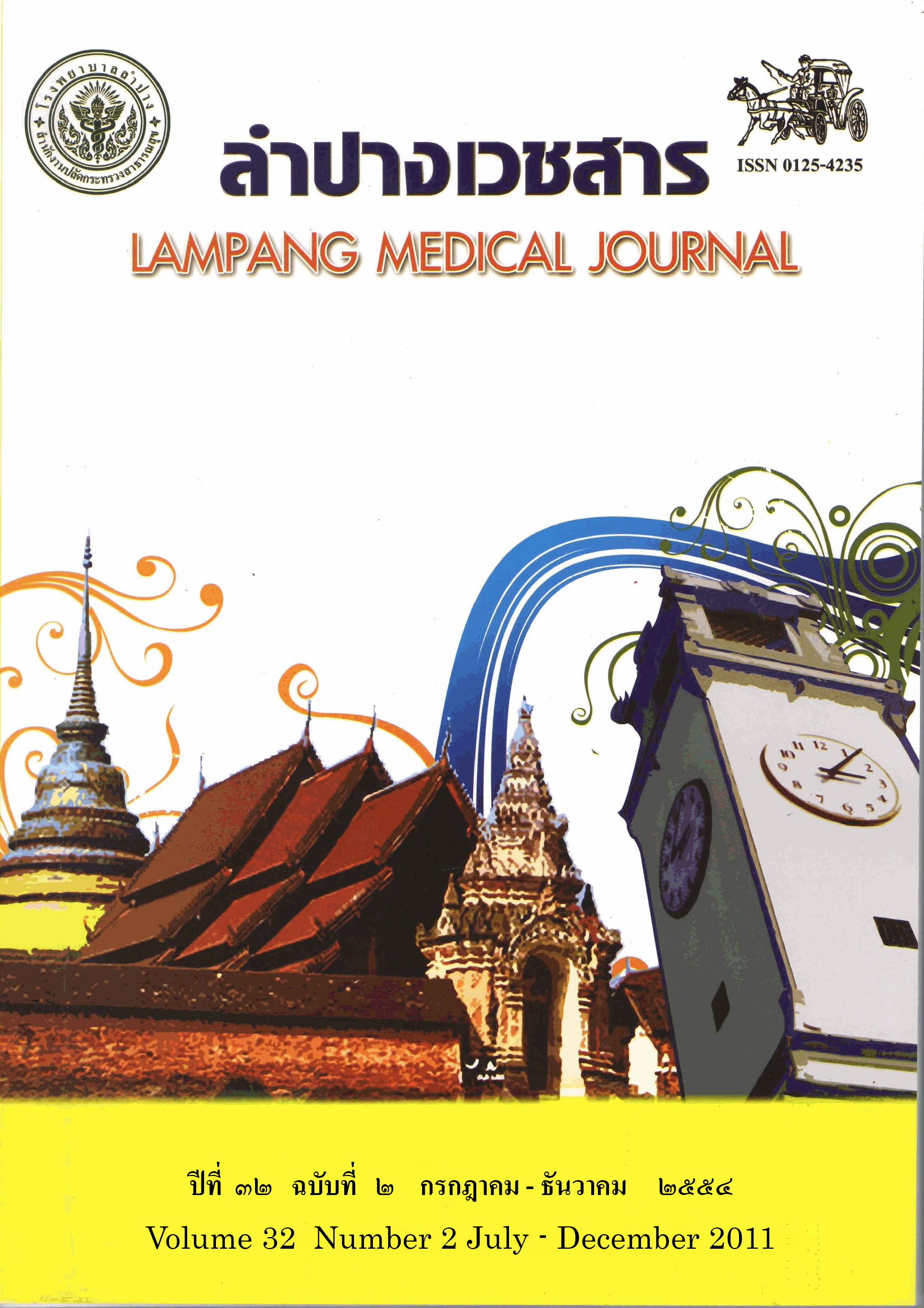Sputum Conversion among Patients with Pulmonary Tuberculosis: Are Two Weeks Enough for Respiratory Isolation?
Main Article Content
Abstract
Background : Surgical mask should be used to reduce aerosols generated from known infectious pulmonary tuberculosis patient. WHO and the United States CDC recommend that the patient should have received standard multi-drug anti-tuberculosis therapy for at least 2 weeks and had 3 consecutive AFB-negative smear of sputum specimens before stopping respiratory
isolation. Such sputum smear was routinely performed at 2 months.
Objective : To explore the sputum conversion rate at 2 weeks in the patients with smear positive pulmonary tuberculosis and risk factors for persistent positive sputum results.
Material and method : A prospective cohort study in 76 recent diagnosed pulmonary tuberculosis patients with positive smear was conducted in Lampang Hospital between October 2010 and May 2011. Sputum was collected for AFB smear and culture at 2 weeks after starting treatment. The sputum conversion rate was calculated. Risk factors for persistent positive sputum results were analyzed by Fisher’s exact test and logistic regression.
Results : 77.6% of the patients were male. The mean age was 52.7 ± 17.8 years (range, 18 - 91). At 2 weeks of initial therapy, 55.3 % and 39.5 % of the patients had persistent positive sputum smear and culture respectively. On stepwise multiple regression analysis, presence of lung cavitation (OR = 5.07, 95%CI 1.40 - 18.39, p = 0.014) and +3 AFB smear grade at the initial treatment (OR = 20.27, 95%CI 1.59 - 258.76, p = 0.021) were the factors independently associated with persistent positive sputum culture results.
Conclusion : Respiratory isolation period of two weeks is not enough for pulmonary tuberculosis patient with positive smear sputum, especially in which lung cavitation or highly smear grade on the initial treatment was found.
Article Details

This work is licensed under a Creative Commons Attribution-NonCommercial-NoDerivatives 4.0 International License.
บทความที่ส่งมาลงพิมพ์ต้องไม่เคยพิมพ์หรือกำลังได้รับการพิจารณาตีพิมพ์ในวารสารอื่น เนื้อหาในบทความต้องเป็นผลงานของผู้นิพนธ์เอง ไม่ได้ลอกเลียนหรือตัดทอนจากบทความอื่น โดยไม่ได้รับอนุญาตหรือไม่ได้อ้างอิงอย่างเหมาะสม การแก้ไขหรือให้ข้อมูลเพิ่มเติมแก่กองบรรณาธิการ จะต้องเสร็จสิ้นเป็นที่เรียบร้อยก่อนจะได้รับพิจารณาตีพิมพ์ และบทความที่ตีพิมพ์แล้วเป็นสมบัติ ของลำปางเวชสาร
References
World Health Organization. Global tuberculosis control: a short update to the 2009 report. Geneva: World Health Organization; 2009.
World Health Organization. Guidelines for the prevention of tuberculosis in health care facilities in resource-limited settings. Geneva: World Health Organization; 1999.
World Health Organization. Tuberculosis infection control in the era of expanding HIV care and treatment: addendum to WHO guidelines for the prevention of tuberculosis in health care facilities in resource-limited settings,1999. Geneva: World Health Organization; 2006.
Taylor Z, Nolan CM, Blumberg HM. Controlling tuberculosis in the United States. Recommendations from the American Thoracic Society, CDC, and the Infectious Diseases Society of America. MMWR Recomm Rep 2005; 54(RR–12):1–81.
World Health Organization. Treatment of tuberculosis: guidelines – 4th ed. Geneva, World Health Organization; 2009.
Fortún J, Martín-Dávila P, Molina A, Navas E, Hermida JM, Cobo J, et al. Sputum conversion among patients with pulmonary tuberculosis: are there implications for removal of respiratory isolation?. J Antimicrob Chemother 2007; 59(4):794-8.
Rieder HL, Chonde TM, Myking H, Urbanczik R, Laszlo A, Kim SJ, et al. The public health service national tuberculosis reference laboratory and the national laboratory network. France: IUATLD; 1998.
Kent TK, Kubica GP. Public health mycobacteriology: a guide for the level III laboratory. Atlanta: Center for Disease Control; 1985.
Senkoro M, Mfinanga SG, Morkve O. Smear microscopy and culture conversion rates among smear positive pulmonary tuberculosis patients by HIV status in Dar es Salaam, Tanzania. BMC Infect Dis 2010; 10:210-6.
Miyazaki Y, Koga H, Kohno S, Kaku M. Nested polymerase chain reaction for detection of Mycobacterium tuberculosis in clinical samples. J Clin Microbiol 1993; 31:2228-32.
Abe C, Hirano K, Wada M, Kazumi Y, Takahashi M, Fukasawa Y, et al. Detection of Mycobacterium tuberculosis in clinical specimens by polymerase chain reaction and Gen-Probe Amplified Mycobacterium Tuberculosis Direct Test. J Clin Microbiol 1993; 31:3270-4.
Horne DJ, Johnson CO, Oren E, Spitters C, Narita M. How soon should patients with smear-positive tuberculosis be released from inpatient isolation?. Infect Control Hosp Epidemiol 2010; 31(1):78-84.
Telzak EE, Fazal BA, Pollard CL, Turett GS, Justman JE, Blum S. Factors influencing time to sputum conversion among patients with smear-positive pulmonary tuberculosis. Clin Infect Dis 1997; 25(3):666-70.
Singla R, Osman MM, Khan N, Al-Sharif N, Al-Sayegh MO, Shaikh MA. Factors predicting persistent sputum smear positivity among pulmonary tuberculosis patients 2 months after treatment. Int J Tuberc Lung Dis 2003; 7(1):58–64.
Ritchie SR, Harrison AC, Vaughan RH, Calder L, Morris AJ. New recommendations for duration of respiratory isolation based on time to detect Mycobacterium tuberculosis in liquid culture. Eur Respir J 2007; 30(3):501-7.
Bawri S, Ali S, Phukan C, Tayal B, Baruwa P. A study of sputum conversion in new smear positive pulmonary tuberculosis cases at the monthly intervals of 1st, 2nd & 3rd month under directly observed treatment, short course (DOTS) regimen. Lung India 2008; 25:118-23.
Wang JY, Lee LN, Yu CJ, Chien YJ, Yang PC. Factors influencing time to smear conversion in patients with smear-positive pulmonary tuberculosis. Respirology 2009; 14(7):1012-9.
Marks SM, Taylor Z, Qualls NL, Shrestha-Kuwahara RJ, Wilce MA, Nguyen CH. Outcomes of contact investigations of infectious tuberculosis patients. Am J Respir Crit Care Med 2000; 162:2033–8.
Girardi E, Raviglione MC, Antonucci G, Godfrey-Faussett P, Ippolito G. Impact of the HIV epidemic on the spread of other diseases: the case of tuberculosis. AIDS 2000; 14 suppl 3: S47–56.
Pitchenik A, Rubinson HA. The radiographic appearance of tuberculosis in patients with the acquired immune deficiency syndrome (AIDS) and pre-AIDS. Am Rev Respir Dis 1985; 131: 393–6.
Klein NC, Duncanson FP, Lenox TH III, Pitta A, Cohen SC, Wormser GP. Use of mycobacterial smears in the diagnosis of pulmonary tuberculosis in AIDS/ARC patients. Chest 1989; 95:1190–2.
Kim TC, Blackman RS, Heatwole KM, Kim T, Rochester DF. Acid-fast bacilli in sputum


